Discover 9 hidden attractions, cool sights, and unusual things to do in Mount Kilimanjaro (Tanzania). Don't miss out on these must-see attractions: Mount Kilimanjaro climbing routes, Furtwängler Glacier, and Credner Glacier. Also, be sure to include Rebmann Glacier in your itinerary.
Below, you can find the list of the most amazing places you should visit in Mount Kilimanjaro (Kilimanjaro).
Table of Contents
Mount Kilimanjaro climbing routes

There are several routes by which to reach Kibo, or Uhuru Peak, the highest summit of Mount Kilimanjaro, namely: Marangu, Rongai, Lemosho, Shira, Umbwe and Machame.
Being one of the most popular mountains in the world, roughly 50,000 trekkers every year try to reach the summit of Mt Kilimanjaro. According to research published by the Climb Kilimanjaro Guide, the average summit success rate across all climbers and routes is 65%. However, summit success rate heavily depends upon what route is climbed as routes vary considerably in terms of acclimatization profile and duration of climb.[1]
Furtwängler Glacier
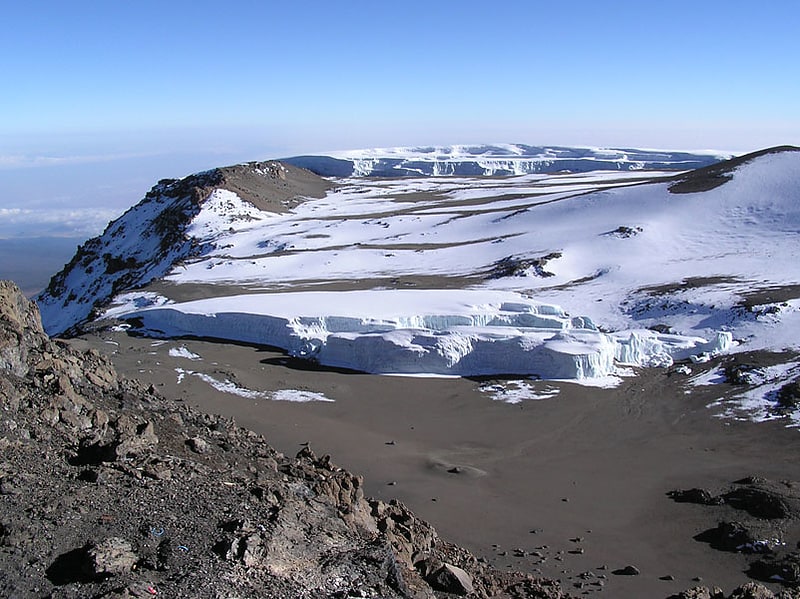
Glacier in Tanzania. Furtwangler Glacier is located near the summit of Mount Kilimanjaro in Tanzania. The glacier is named after Walter Furtwängler who, along with Siegfried König, were the fourth party to ascend to the summit of Kilimanjaro in 1912.
The glacier is a small remnant of an ice cap that once crowned the summit of Kilimanjaro. Almost 85 percent of the ice cover disappeared from October 1912 to June 2011. At the current rate, most of the ice will disappear by 2040 and "it is highly unlikely that any ice body will remain after 2060".
Furtwängler Glacier is ephemeral, existing continuously only since about 1650 CE, which corresponds with very high levels in Kenya's Lake Naivasha and the beginning of the Maunder Minimum. Between measurements in 1976 and 2000, the area of this glacier was cut almost in half, from 113,000 square metres (1,220,000 sq ft) to 60,000 square metres (650,000 sq ft). By 2018 the size shrank to 11,000 square metres (120,000 sq ft).
During fieldwork conducted early in 2006, scientists discovered a large hole near the center of the glacier. This hole, extending through the 6 metres (20 feet) remaining thickness of the glacier to the underlying rock, split the glacier in two by 2007.[2]
Credner Glacier
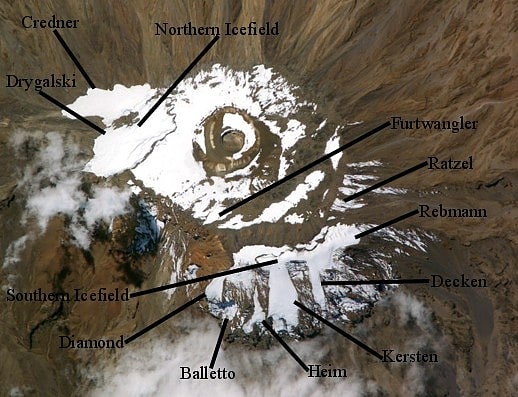
Glacier in Tanzania. Credner Glacier is on Mount Kilimanjaro in Tanzania, on the northwest slope of the peak and is a remnant of an icecap which once crowned the top of Mount Kilimanjaro. The glacier is situated at an elevation of between 5,800 and 5,500 metres. Credner Glacier is one of the largest glaciers on the mountain and descends from the Northern Ice Field. Credner is rapidly retreating due to its high exposure point on the northwest slope of Mount Kilimanjaro. A report published in 2013 indicated that in another decade the glacier may no longer exist.[3]
Rebmann Glacier
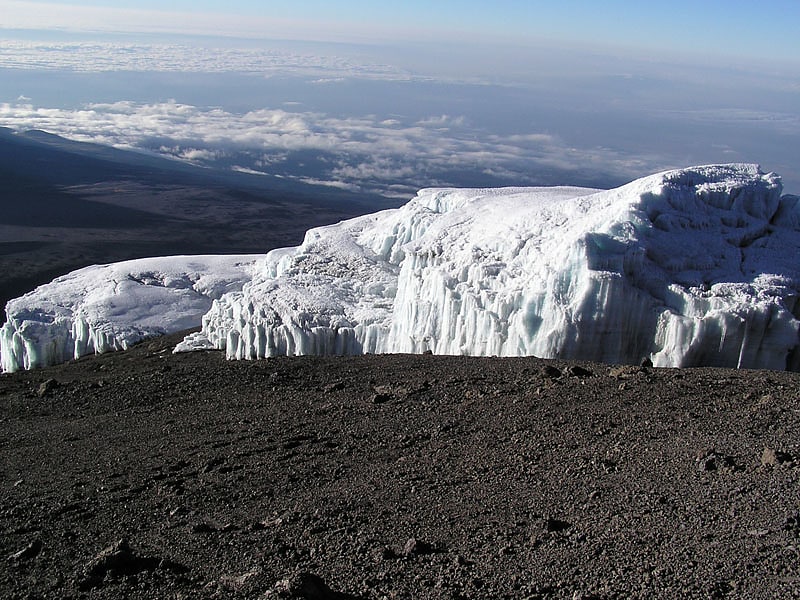
Glacier in Tanzania. The Rebmann Glacier is an active glacier located near the summit of Mount Kilimanjaro in Tanzania. It is a small remnant of an enormous ice cap which once crowned Kilimanjaro. This ice cap has retreated significantly over the past century; between 1912 and 2000, 82 percent of the glacial ice on the mountain disappeared.
Rebmann Glacier is named for German missionary and explorer Johann Rebmann, who was the first European explorer to report observations of snow and glaciers atop Kilimanjaro, in 1848.[4]
Northern Ice Field
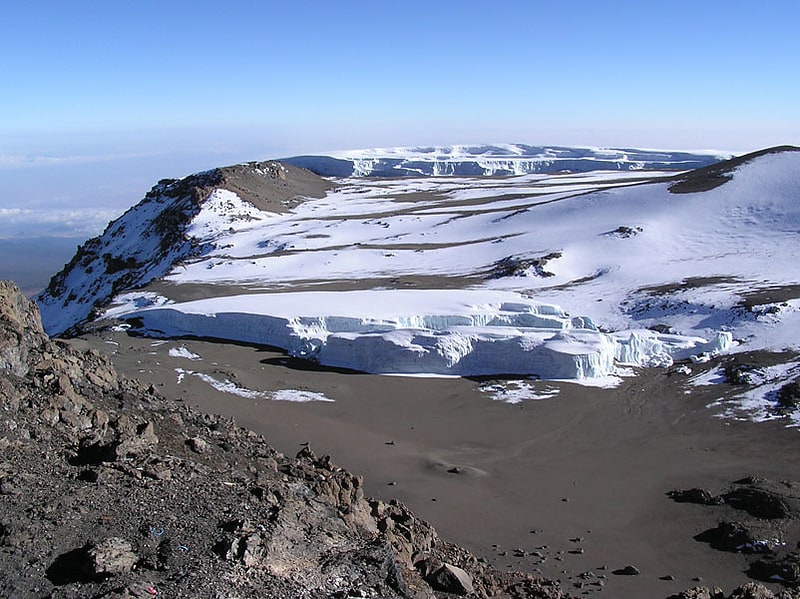
Ice field in Tanzania. The Northern Ice Field is near the summit of Mount Kilimanjaro in Tanzania, on the west slope of the peak. The Northern Ice Field and Eastern Ice Fields were connected to the Southern Ice Field and formed part of a continuous body of glacial ice atop Mount Kilimanjaro when first scientifically examined in 1912. By 1962 the Southern Ice Field separated from the Northern Ice Field and then by 1975 the Eastern Ice Field did as well. In 1912, the glaciated areas atop Mount Kilimanjaro covered 11.40 square kilometres; by 2011 this had been reduced to 1.76 square kilometres, an 85 percent loss. At one time, ice flowing off the Northern Ice Field fed numerous glaciers, including, north to south, the Credner, Drygalski, Great Penck and Little Penck Glaciers.
The Northern Ice Field is the largest body of ice remaining on Mount Kilimanjaro, with an area of 0.95 square kilometres (0.37 sq mi), when measured in 2007. During the exceptionally cold period known as the Younger Dryas, which occurred approximately 12,800 and 11,500 years BP (between 10,800 and 9500 BC), Mount Kilimanjaro may have been ice-free. While conditions during the Younger Dryas were cold enough to support ice, it was also exceptionally dry, so much so that the region where Mount Kilimanjaro is located was semi-desert. Ice core samples taken from the Northern Ice Field date only from the end of the Younger Dryas and have been dated at 11,500 years. Dust deposits in the ice core samples coincide with periods of suspected warming conditions such as the Medieval Warm Period (1000–1270 AD). The ice cores also indicate that during the Little Ice Age (1270–1850 AD), the Northern Ice Field and other glaciated areas on Mount Kilimanjaro likely expanded; this was due to not just to cooling temperatures, but also a wetter climate. Ice cores drilled into the Northern Ice Field in 2000 went through the glacier to bedrock, a total distance of just over 50 m (160 ft).
The current state of retreat of the glaciers on Mount Kilimanjaro has been attributed to both warmer and drier conditions than were present during the Little Ice Age. Tropical glaciers tend to be more greatly impacted by moisture than those found in the mid-latitudes or polar zones and drier conditions can lead to higher percentages of glacial loss due to the higher amount of radiational heating in tropical zones, though most of the tropical glacial loss is still primarily attributed to a warming climate.
This pattern of retreat is not anticipated to change and most if not all the ice on top of Mount Kilimanjaro may be gone by 2040. Since 1984, the Northern Ice Field developed a hole near its center point which by 2003 had opened into a canyon exposing rocks for the first time in 11,000 years. By 2011, the Northern Ice Field had split in two. The retreat is not just along the margins. Between 2000 and 2007, the Northern Ice Field thinned by an average of 1.9 m (6 ft 3 in).[5]
Barranco Glacier
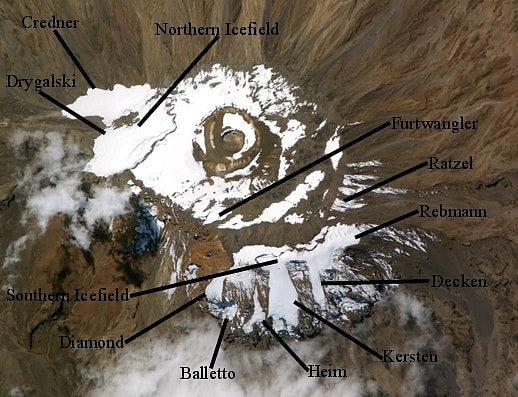
Barranco Glacier is near the summit of Mount Kilimanjaro in Tanzania, on the southwest slope of the peak and is a small remnant of an icecap which once crowned the top of Mount Kilimanjaro. The glacier is situated at an elevation of between 5,200 and 4,800 metres. The Great Barranco Glacier was far larger when first documented in the late 19th century and it along with the now extinct Little Barranco Glacier may have been fed by the Furtwängler Glacier which is on the top of the mountain. By 2011, Barranco Glacier was reduced to two small disconnected and dormant ice bodies.[6]
Arrow Glacier
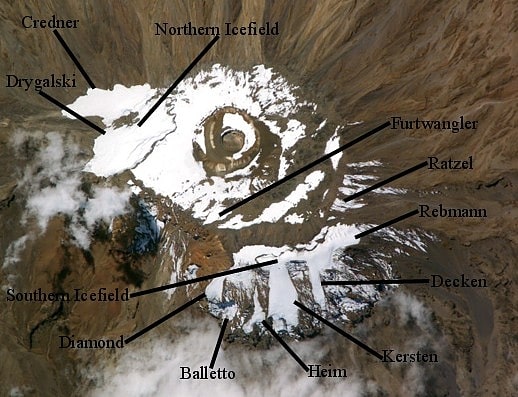
Glacier in Tanzania. Arrow Glacier is located near the summit of Mount Kilimanjaro in Tanzania, on the west slope of the peak and is a small remnant of an icecap which once crowned the summit of Mount Kilimanjaro. The glacier is situated at an elevation of between 5,470 and 5,300 metres. Arrow Glacier is adjacent to a climbing route known as the Western Breach/Arrow Glacier Route or more commonly, the Lemosho Route. Arrow Glacier is a recently named glacial remnant that may not even exist as of 2011. It was what remained of an earlier glacier known as the Little Barranco Glacier.[7]
Drygalski Glacier
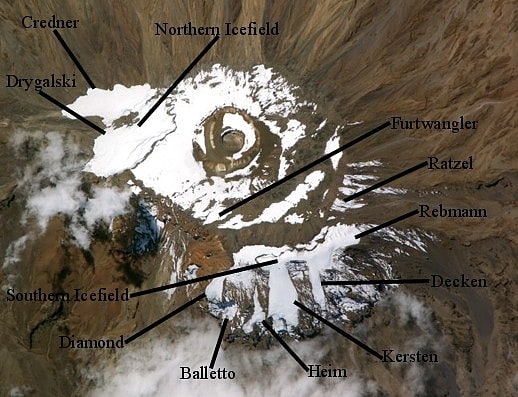
Drygalski Glacier was on Mount Kilimanjaro in Tanzania, on the northwest slope of the peak. The glacier terminus once extended to an elevation of 4,800 metres with an origination point near the summit of Mount Kilimanjaro and was fed by the Northern Ice Field. The Great Penck Glacier once flanked Drygalski Glacier to the south and until recently, the Credner Glacier did as well to the north. Drygalski Glacier is named for German geographer Erich von Drygalski.[8]
Great Penck Glacier
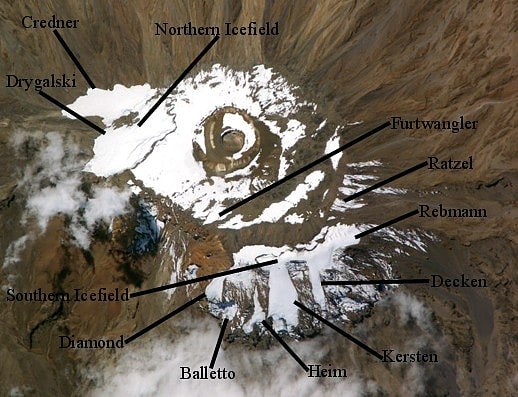
Great Penck Glacier was on Mount Kilimanjaro in Tanzania, on the west slope of the peak. Extending from the Northern Ice Field, the glacier once flowed 2.4 kilometres, to an elevation of 4,750 metres. Between the years 1962 and 1975, Great Penck Glacier separated from the Northern Icefield and disappeared. Drygalski Glacier once also existed to the north of Great Penck, while the same is true of the Little Penck Glacier, which was to the south.[9]